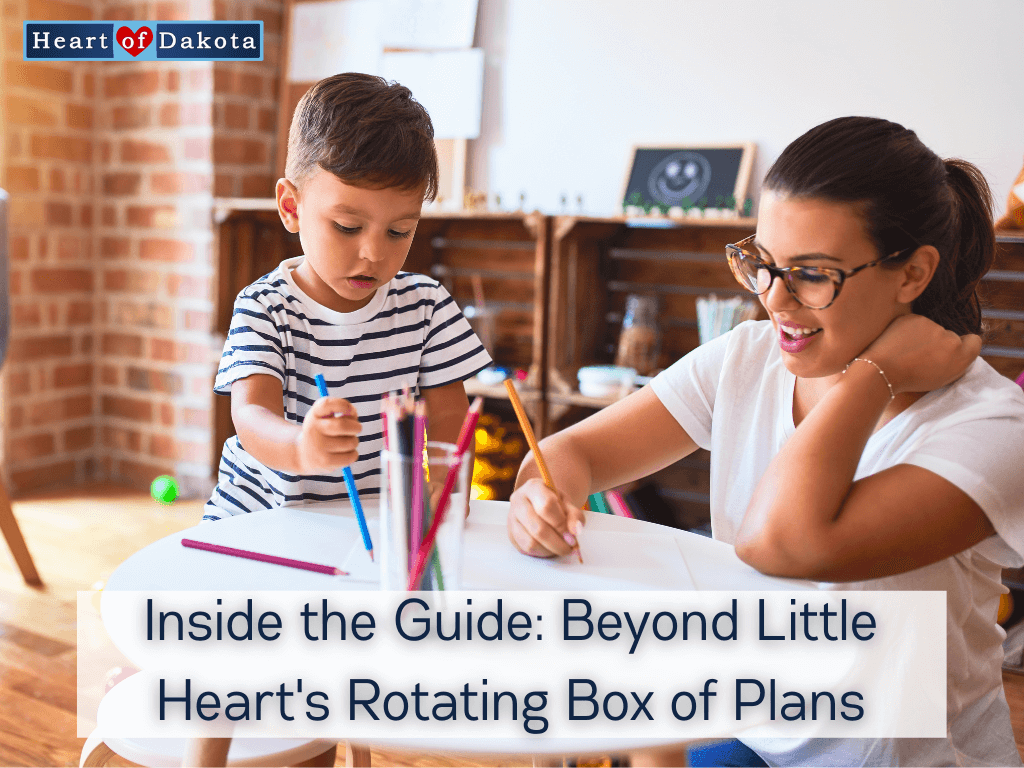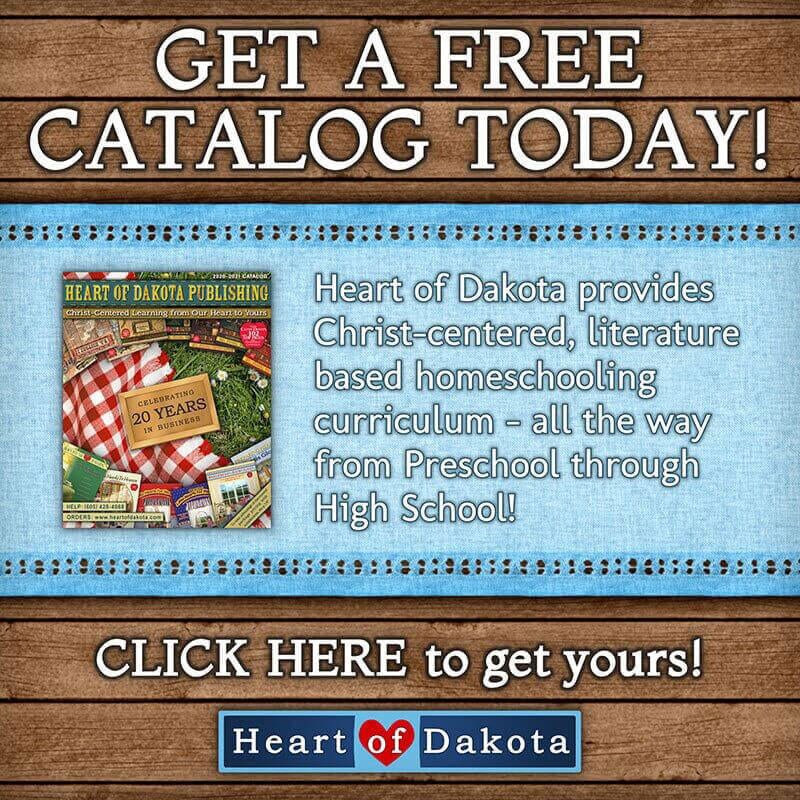Inside the Guide: Beyond Little Heart’s Rotating Box of Plans
This “Inside the Guide” series provides a quick snapshot of Beyond Little Heart’s Rotating Box of Plans! It’s a handy “how-to” reference, just one box of plans at a time. Have you ordered Beyond Little Hearts for His Glory from Heart of Dakota, or are you considering ordering it soon? Well, either way, here’s your quick-start “Inside the Guide” for… Beyond Little Heart’s Rotating Box of plans!
Quick Start Info
Time It Takes: 15 to 20 minutes
Days It’s On: Days 1, 2, 3, 4, and 5
Description: Beyond Little Heart’s Rotating Box of plans can be found on the bottom left side of the daily plans. Though the skills taught in these boxes rotate, every box connects to the history theme in its own special way. The rotating boxes of plans include: Geography, Science Exploration, Timeline/History Activities, and Artistic Expression. Each of these is done once a week, with the exception of Science Exploration, which is done twice a week. This rotation allows many skills to be taught within a week and keeps each day fresh with varied things to do. Beyond Little Heart’s rotating boxes teach additional skills without adding too much time to the day.
A Handy How-To for Beyond Little Heart’s Rotating Box of Plans
For Geography, children explore a geography concept that stems from the history study. Concepts range from learning about the continents and oceans, to tracing the routes of explorers, to reading maps, and to following directions. You’ll need a globe and a world map for this box of plans. These are great purchases, as you’ll need them virtually every year of homeschooling!
For Science Exploration, children delve into life science, physical science, and earth science topics. Readings from the science book God’s Wonderful Works provide the textual content for each lesson. Quick hands-on activities relate to the science readings, reinforce scientific vocabulary, and connect to both the Bible and the history reading for the day.
For Timeline/History Activities, children participate in short, engaging activities that make the history stories come alive. Children also keep a basic timeline of the major historical events studied throughout the year.
For Artistic Expression, children creatively respond to the history story. Hands-on art projects encourage self-expression and teach needed skills. The focus is on the artistic process, rather than creating a perfect product. Common art supplies and household items make these projects quick and easy.
General Rotating Box Notes
Since the rotating boxes all link to the history readings, be sure you’ve read the Reading About History book before doing the rotating boxes. Hands-on activities that require supplies really do use common household items and art supplies. Beyond Little Heart’s Rotating Boxes of plans also often suggest substitutions (i.e. use cereal pieces, chocolate chips, or mini marshmallows). Finally, after completing each rotating box, you can read aloud the Key Idea in the Beyond Little Heart’s guide. It ties the rotating activities to the history theme beautifully!
Geography Notes
Geography was a blast! It taught many skills but in such fun ways that they made it seem like we were just on an adventure exploring America. Even though Geography is fun, kiddos still learn important basic geography skills, become familiar with geographical terms, read maps, follow directions, and draw simple maps. I used to think of Geography as being pretty bland, but connecting it to history makes it so interesting! The first week kicks off the fun by having kiddos discover the routes of famous explorers as they skip/hop/jump to and from continents labeled with cards on the floor! What a genius way to learn two things – explorers’ routes and the names/locations of all continents! The fun continues all year, and at the end – kiddos know a lot about both Geography and History.
Science Discovery Notes
The Science Discovery box of plans uses the Christian science text God’s Wonderful Works. I always read the science text before doing the science activity. I did this cuddled up on the couch, with the science book open for us both to see it clearly. The history topic is still the unifying theme though, so the science is planned in an order to best connect with the chronological history. The science book will not be read in order for this reason. The more a “unit study” can be incorporated, the better. This helps with retention, and connecting all the rotating boxes to the history theme helps each day feel consistent. Common household and art supplies are truly used for the science, so I did not read ahead to gather things.
Timeline/History Activities Notes
The Timeline/History Activities brings history to life with fun activities like building (and fixing) a clay dike, constructing a miniature house frame, following a marked trail along the Wilderness Road, baking simple cornbread, singing “Yankee Doodle”, and more! Children also keep a basic timeline of early American events studied throughout the year, which helps them see the big picture of how these events fit together.
The timeline you make on Unit 1 Day 4 will be used all year, so follow the directions carefully! Feel free to adjust the size of the timeline – that is the beauty of making it yourself. I made the timeline have bigger rows/columns for my son who was still drawing/writing big. For my perfectionist son, I had a good eraser and erasable colored pencils. One son had trouble with perspective – he drew things way too big or way too small, and he forgot to leave space under the picture to write the caption for the timeline entry. It helped for me to draw a quick sketch of the timeline item on a markerboard.
I did not aim for a beautiful, flawless example! This is not an art project, so I accepted what each son was able to do drawing-wise. I did expect things to be colored the appropriate colors (no purple forts or green log cabins). Likewise, the caption had to be spelled properly with the right words/year. You can lightly write the captions in pencil on the first day if needed, and have your kiddo trace them just to get an idea of the size they should be.
Artistic Expression Notes
The Artistic Expression box sometimes includes “youngers” and “olders” options. This makes extending the activity for artistically-inclined or older kiddos easy! My three children varied greatly in artistic abilities and fine motor skills like coloring, gluing, cutting, drawing, painting, etching, etc. I made a point to remember the purpose of Artistic Expression was to focus on the creative process. I liked to start them off and help them as needed – but NOT take over the whole thing! Then it would have been my art project instead of theirs! I often hung their completed art projects on the fridge with a strong magnetic clip. They loved showing their brothers and my hubby when he came home from work! They also liked to display their very favorite art projects in their rooms somewhere, like on an end table or propped up on a dresser.
To order this amazing science book, click here! To order complete Beyond Little Heart’s packages, click on the baskets here!




This Post Has 2 Comments
I love the tip for the timeline about drawing a quick sketch on a markerboard first! I didn’t do that with my first son when he did Beyond, but I think this will help his younger brother who is starting Beyond next month.
Oh good! Thanks, Jaime! The quick sketch especially helped my oldest, as it gave perspective about the size of the drawing, as well as the nuts and bolts outline of it. Then, he was off and running with it! I hope it helps with your son starting Beyond Little Hearts this year!